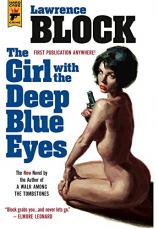The Girl with the Deep Blue Eyes
Review
The Girl with the Deep Blue Eyes
In case you needed more proof, THE GIRL WITH THE DEEP BLUE EYES establishes once and for all that Lawrence Block is among the greatest mystery writers America has ever produced. His work ranks up there in noir with names like Hammett, Chandler, James M. Cain and Jim Thompson.
Speaking of Cain, author of DOUBLE INDEMNITY and THE POSTMAN ALWAYS RINGS TWICE, Block takes on in this book the basic Cain noir plot: woman seeks man to knock off her husband for the money. Thousands of authors and movies have tackled this theme of betrayal, greed and lust. But nobody since Cain has done it as well as this.
High praise, indeed. But Block deserves it. THE GIRL WITH THE DEEP BLUE EYES is about as perfect a pulp, noir tale filled with psychological tension and great plot twists as you will ever read. It is sexy and dark, and a tremendously fun read. This is Cain on Viagra. The first chapter is about as sexually explicit as you will find anywhere; it is hot enough to start a forest fire.
And therein lies the genius of Block’s accomplishment. When Cain wrote his books and the great film noirs that were based upon them were made, America existed under de facto censorship of the arts. If Cain wrote Block’s book, it never would have gotten by the post office inspectors. It could not have been shipped through the mail. Booksellers could have been jailed for selling it. Double Indemnity took years to get filmed since the script could not get approved by the Hollywood censors of the Production Code. Too incendiary for mid-century America.
"THE GIRL WITH THE DEEP BLUE EYES is a little book that just might be Lawrence Block’s masterpiece, which is quite a statement when you consider all the outstanding work he has done for over half a century."
Block has written here the book that never could have been written almost a century ago. It is not so much that he copies or updates the basic story, he takes it in new, unexpected directions. People so inclined might focus on the sex, which is vigorous, but it is the psychological tension that keeps you turning pages. It is impossible to anticipate how the story is going to end, and even on the last page, you are wondering what will happen next. Block’s writing is masterful.
The story is told from the point of view of Doak Miller, a 48-year-old retired NYPD veteran who has relocated to Gallatin County, Florida. He gets a PI license to supplement his retirement, and is soon freelancing for the county sheriff running sting operations on folks looking for a hit man to dispose of the human garbage in their lives. Enter Lisa Otterbein (note to mystery writers: great name), the young second wife of a local real estate man.
Doak is something of a randy fellow, easily falling into multiple sexual liaisons. But when he sees a picture of Lisa, the story takes a romantic turn, which you would not expect in noir. Block writes: “He could feel the fantasy hovering out there on the edge of thought… He meets this woman, and their eyes lock, and they connect in a way that neither of them has ever before connected with another human being.”
Wow! When they meet later, Doak exclaims, “Jesus, the blue of her eyes.” Game on. She responds to his fantasy, and at one point they simply consider running away. This is not a great idea since Lisa stands to pick up $5 million if her hubby, George, dies. They soon are in bed co-conspiring to commit murder.
What makes this book not just pulp fiction but literary art is the psychological journey of our narrator. This is a hardcore noir journey, exposing the secret lives of people pushed to the edge of desperation where true darkness exists. This is the darkness at the edge of our towns. There are no heroes here. There are just people. Block shows them as generally sound, ordinary and reasonable. And we can easily like them. But the narrative keeps you off balance, off kilter in this noir world, just as it would be if real people were living it.
So it is agreed that Doak is going to kill George, who is far from a saint and an adulterer himself. But as Doak and Lisa reveal their life stories in incredibly frank pillow talk, it emerges that Doak has killed before while a cop. Block writes, “I liked the feeling. I like pulling the trigger, I like watching the man die. It was like (sex).”
At that point, the reader is left to wonder if Doak is an unreliable narrator, as perhaps his romantic notions hide something far darker. This becomes very clear when he nearly strangles a casual sexual partner and has the overwhelming urge to kill her. He resists, luckily, but then questions himself in a devastating, unforgettable scene.
Great noir is subversive because it tells the truth about people, the truth we often cannot face. We know that there is evil in this world, but we naively think that evil comes from “the other.” Bad things might happen to us, but they are not our fault. We are the ultimate unreliable narrators of our lives. Noir suggests that we are saints and sinners often at the same time, that the darkness and evil is far closer to us, maybe inside us, waiting for the right moment to appear and wreak havoc in the name of love or country or something else we think up.
THE GIRL WITH THE DEEP BLUE EYES is a little book that just might be Lawrence Block’s masterpiece, which is quite a statement when you consider all the outstanding work he has done for over half a century. Like the work of Cain and the other great writers, it will be read and studied for generations. And hopefully filmed someday. Assuming, of course, that the darkness does not do us all in on one of these fine, romantic days.
Reviewed by Tom Callahan on September 24, 2015
The Girl with the Deep Blue Eyes
- Publication Date: September 22, 2015
- Genres: Fiction, Hard-boiled Mystery, Mystery
- Hardcover: 240 pages
- Publisher: Hard Case Crime
- ISBN-10: 1783297506
- ISBN-13: 9781783297504





